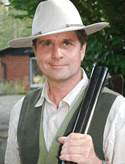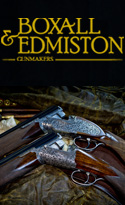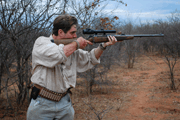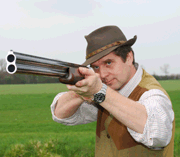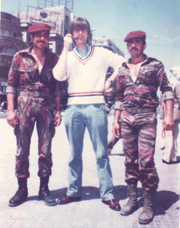Teaching Young Shots
As a father of four, I have a special interest in teaching Young Shots. My two boys are keen shooters, and both have bagged their first pheasants in the last couple of years. They both shoot clays too. Jamie my eldest boy shot 50 ex 60 in his first sporting competition at Hollland & Holland, and we have won two events as members of the same team together - if you detect a bit of prde you're right. Harry, my youngest son, and I once managed to win the father and son event at the British Schools Championship - another red letter day. My eldest daughter, Alexandra, has just asked me to continue with her shooting education (lapsed for some years) because she has friends who shoot. And, my youngest, Elizabeth, is still making up her mind – she has bags of natural ability and is a most efficient clay buster with .410 or 20. I think it is absolutely essential not to push a child into shooting just because it is one’s own sport. Help them if they show interest, but don't push it.
There are, meantime, quite a few pitfalls in teaching young people to shoot. I frequently see well meaning parents or part-time instructors going about it in the wrong way. My kids took their first shots with an air-rifle when they were very young (and I advocate training/practice with an air gun before shotgunning is considered). This was an occasional treat. I would set up knock-down targets or a tin can in the garden. We all had a lot of fun. Even before these first shots with a ‘real’ gun, my brood had had the safety message constantly re-enforced. They were not allowed to point their toys guns at people.
Never, never, let your gun…was a mantra that they all knew by the age of 6. Living in a house where guns were frequently seen (but always secured) and with a father who is a shooting instructor required that they should take on board the basic rules of safety early. My two youngest kids also had significant experience of beating from an early age, as well as watching their dad teach people to shoot. This sort of ‘secondary’ shooting experience is extremely useful – something from which many urban kids do not usually benefit. The bottom line is that they became safety aware from a young age and accepted guns and shooting as something ordinary.
If you are going to attempt teaching a child or young person to shoot, I would say first, that you should consider letting a professional, at the least, start the process. I’ll be frank, I just see too many kids receiving poor instruction. With that caveat in place, let me note some of the basics if you are determined to pursue the DIY route.
Safety
You must be aware of safety at all times. You must brief your student on the basics. Don’t over do it – young minds, like adult ones can only take in so much. You should emphasise, however that guns are dangerous, that you should never point a gun at something you do not wish to shoot, and that one must always check that a gun is unloaded when you pick it up, put it down or pass it someone else. I like to demonstrate the power of a shotgun by shooting a plastic milk container full of water. This can be quite spectacular and stays in the mind. I also like my young shots to make a point of putting their finger in the empty chamber or chambers and saying ‘clear’ when they are proving guns unloaded. Never forget, though: YOU ARE RESPONSIBLE.
Eye Dominance
It is rare for a young shot to be able to shoot with both eyes open. You should test for eye dominance as you would with an adult, but you will usually find that kids (like most women) have what is best described as indeterminate eye dominance where both eyes fight for control (frequently misdiagnosed – even by professionals – as left eye dominance). The simple way round this is to close one eye or to place a patch over it (which might be attached to safety glasses – like ear protection, a necessity for young shots).
Guns
It is vitally important that you select the right gun and cartridge for your student. The gun should not be too heavy – the key point is that your protégé must be able to support the gun without arching the back (a common reaction to an over-heavy gun). For the very young, I have found nothing better than a Webely .410 bolt action – they are not expensive and they shoot very well. I do not like to use cheap single barrel break action guns or folding .410s with single or double barrels. If you are wondering why, try shooting one! Usually they are ghastly contraptions with very heavy trigger pulls.
Lincoln and Rizzini offer some excellent .410, 28 and 20 bore over and unders at reasonable cost. Beretta’s Silver Pigeon in 28 or 20 bore would also be ideal if you want to spend a little more. In the case of the 20, I would usually advise the 28” fixed choke gun – as there is less weight to the front. 20 bore, gas operated, semi-automatics are also worth consideration. Some will use side by sides. The little Yildiz .410 is especially good value, there are also some excellent Spanish box-lock small-bores (which are even better value if bought second-hand). Generally, however, I would prefer an over and under. I think that they are significantly easier to shoot. This is not a prejudice, I do a lot of shooting with my own side by sides, it is a professional observation. Side by sides do not control recoil as well, nor do they point as well as well made over unders.
Gun fit
Gun fit is another critically important consideration for young shots. Kids have smaller heads than adults, consequently they need a high comb as well as a shorter stock (assuming that they are of shorter than adult stature). The cheap way to raise a comb, is to use a rubber comb raiser fixed with vinyl electrician’s tape (you can also use plasticine or corrugated card strips). Without getting too complicated what we want to achieve is a stock fit where the young persons pupil is ‘sitting’ on the breech/rib when their head is in a comfortable position down on the stock.
With regard to length, if you shorten a stock down for a young shooter, make sure that you keep the off-cut (as kids are guaranteed to grow like weeds). When I shorten a stock, I also tend to make it a little longer than ideal for the same reason. When fitting an adult I like to see two finger widths between the base of the gripping thumb and the tip of the nose. With rapidly growing young shots, I usually increase this to three or four finger widths.
Cartridges
Cartridge selection is as important as gun selection when teaching kids. If they get punished by recoil, they will be put off shooting for life. If you are using a .410 opt for 2 or 2 ½” shells. If you are using a 28, make sure that you get light payload cartridges 21 grams or, preferably, less. With a 20 go for subsonics or light payloads, too, and with a 12 do not consider anything else other than 24 gram shell. I especially recommend the Express HV 24 in plastic or fibre and Hull Chevron Low Recoil.
Target selection
Kids must see success in their first (and subsequent) lessons or they will lose heart and not be inclined to continue. Far too often I see young shots (and adult beginners) being thrown in at the deep end and being presented with target that are far too hard. The targets required for ab-initio instruction are as follows: a floppy incomer going to one side of the firing point, a slow going away bird, low 2 on a skeet range (or high 6 for a left-hander), and, a slow rabbit if available.
Technique
I want to keep this simple this month. Show your student how to hold the gun properly. Rear thumb wrapped around the grip, front hand in a mid-way position on the forend (assuming an over and under or semi). Emphasise the importance of keeping the HEAD ON THE STOCK and the weight FORWARD. Show the required relationship between bead and bird (I keep an epoxy mini-target for doing this). Take real care with foot position. Stand square to point where the target will be shot, take half a pace forward with the left foot (assuming a right-hander). Have a couple of shots dry – and if it’s the first few birds it should be the floppy incomer – before shooting a target with a cartridge in the gun. Do not be afraid of offering a little support under the action or barrels if it helps. A gentle push on the shoulder may encourage a weight forward head on the stock stance. Be gentle, don’t rush, and be ready to physically intervene at any moment. The bird is coming NOW, don’t rush, BANG! If someone other than you is smiling all is going well.


